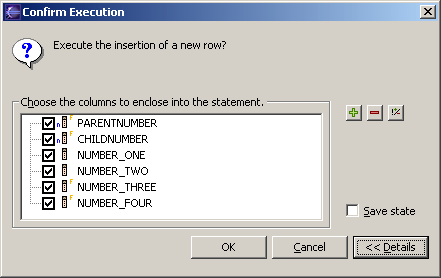Confirmation Dialog
Before the Table Editor executes a
statement, this dialog appears to let you confirm the
execution. If
you press details, the dialog will be expanded to show the columns
of the current database table. By default, the primary key columns are
turned on. If the table has no primary key all check
boxes are turned on respectively. That means that these columns will be
used to form
the where-clause of the
statement.
If you want to explicitly ignore one or more columns when executing the
statement you can force this by unchecking the appropriate columns.
Note: If you uncheck all columns
while confirming a delete statement, then this will definitely clear
the
entire table because the statement executed will look like delete from <tablename>. The same is true for update statements
which will then look like update
<tablename> set <columnname>=<value> and do affect all rows of the table.
The Save State check
box is turned off
by
default. This means that the check state of the columns is valid only
for the current statement. Turning it on lets DbEdit remember
this state for further statements on the same database table. States
are
saved separately for Insert, Update and Delete statements.
The state is saved as long as
- the connection is established or
- you refresh the table using the Refresh
entry from the Tables View's context menu or
- you change or turn off the Save State check box on a following
statement or
- the setting of the preference 'Always warn before submittion of
the following statements...' from the DbEdit preference page is turned
off. This will always lead to a complete reset of the check state back
to the default.
If the dialog prompts while a previously saved state has been
detected, then the Details
button will indicate this by showing a blink effect (periodically
changing it's font).



